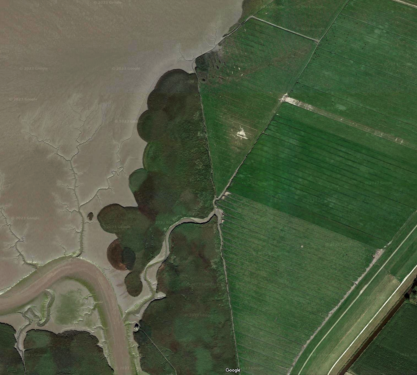Residency
2023-2026: Ems-Dollard Estuary, NL & DE
The Horizon 2020 project WaterLANDS (Water-based Solutions for Carbon Storage, People, and Wilderness) has selected six artists to complete a 4-year part-time placement as part of the WaterLANDS Artistic Engagement Residency.
EU Horizon has funded the selection of six artists to each reflect on one of six different ecological restoration sites in Europe as part of the large-scale and ambitious project ‘WaterLANDS‘ (2023-2026).
Artists: Maria Nalbantova (Bulgaria), Elo Liiv (Estonia), Christine Mackey (Ireland), Claudio Beorchia (Italy), Marjolijn Dijkman (Netherlands), and Laura Harrington and Fiona MacDonald(Feral Practice) (United Kingdom).
Marjolijn Dijkman develops ‘Turbid Tides’ in relation to one of these six sites, reflecting on ecological restoration and depoldering in the context of the Ems-Dollard estuary and the surrounding landscape in the North of the Netherlands. This will lead to presentations in 2026 and 2027.
An intuitive and artistic approach to landscape projects like this can reveal hidden stories and relationships that might be overlooked. In the first phase of her research, she visited the restoration sites several times a year during various stages in the construction and development process. These locations involve many different aspects that influence each other, including dredging on sedimentation in the water, the effects of gas extraction and peat oxidation on subsidence, and sea level rise on water management.
The estuary is depleted of life because of the siltation of the water. The water quality problems and the need to reinforce flood defenses have led to the idea of engineers to remove sediment from the estuary in a newly created intertidal area in the hinterland. The silt in the Ems-Dollard estuary can be considered a kind of antagonist and, at the same time, protagonist in the story of the recovery process in and around the estuary. When the water silts up, it kills organisms in the water, but at the same time, it can bring a fertile layer of clay to land.
Ecological restoration is part of a philosophical “recovery process” from the dominant European worldview that divided nature and culture to allow for economic exploitation. These projects in the coastal zone require a shift in perspective and a new form of dealing with our environment. In his book ‘The Good Ancestor,’ Roman Krznaric, an Australian philosopher, used the rich history of the construction and maintenance of the dikes in the Netherlands as an example of long-term thinking and intergenerational care. These aspects are essential when considering the restoration process of the coastal zone and its inhabitants.


